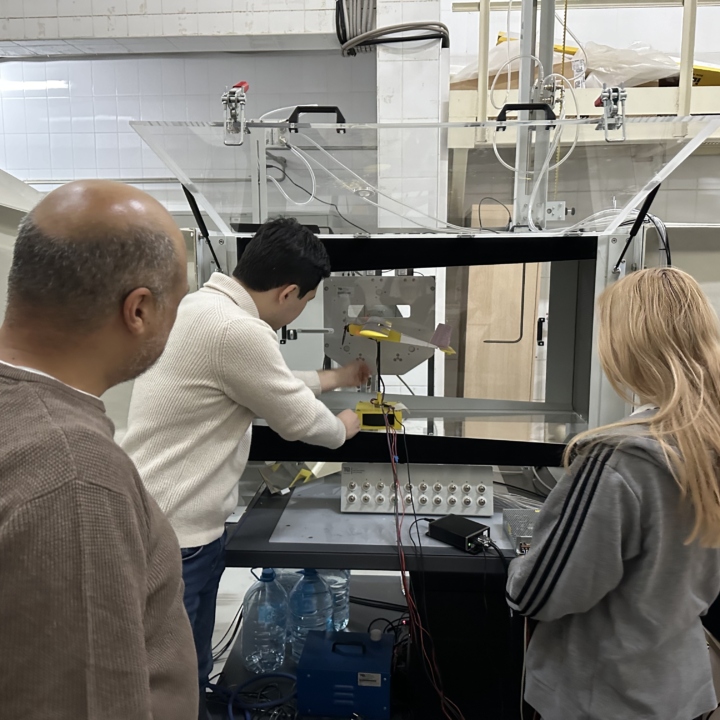About Nazarbayev University
Nazarbayev University is an autonomous research university situated in Astana, Kazakhstan. The Department of Mechanical and Aerospace Engineering situated within the School of Engineering and Digital Sciences, is one of the largest departments with a yearly intake of 35-40 students enrolling onto the Aerospace speciality to study Aerodynamics, Flight Performance and Mechanics and Unmanned Aerial Vehicle Design. The courses offer fundamental knowledge and advanced topics of aerial dynamics, control, mission planning, navigation, and autonomy, bridging the gap between theory and practicality.
What can you tell us about the Lab and experiments?
The university invested in TecQuipment largest open-circuit subsonic wind tunnel (AF1600S) as it offers flexibility in carrying out several experiments, serving the course learning objectives in the aerospace courses. It is equipped with a force balance that measures lift, drag and pitching moment, comes with a variety of test models that are easily interchangeable, and includes the Versatile Data Acquisition System (VDAS) for accurate real-time data capture. In introductory courses, the students investigate aerofoil characteristics using the NACA0012 Aerofoil with Tappings (AF1600B) to characterize aerofoil flows and the NACA0012 Aerofoils (AF1600D) to understand the subtle differences between two- and three-dimensional flows.
In advanced courses, the students investigate the principles of aircraft trim, performance, and control by developing their own powered and actuated models. The versatility of the wind tunnel gives them a chance to measure and validate their unique innovative concept designs and bridge the gap between theory and practicality.
Key Experiment’s Explained - Demonstration of Aircraft Trim, Performance and Control
One of the experiments performed using the Subsonic Wind Tunnel (AF1600S) is a simple experiment demonstrating the concept of aircraft trim, performance and control. Two research assistants, Almira and Rauan, involved in this interview and project, designed an actuated model plane that could freely pitch and be supported by a sting, measuring lift and drag forces in real-time. Independent actuation of propeller thrust and elevator settings are possible in this experiment.
Students studying flight mechanics can appreciate the theory they study in static stability by easily modifying the elevator settings and observing the different associated trim angles, solidifying the concepts learned in class.
Students studying flight performance can investigate the relationship between thrust or power and speed of flight, by adjusting the propeller thrust to balance the model. They can adjust the thrust manually or by use of a controller.
Finally, students studying aircraft dynamics can observe and record the different modes of longitudinal flight.
In their experiment video, Almira and Rauan talk through how they use the Subsonic Wind Tunnel (AF1600S), including the standard control panel, custom-made model and a flight instrument measurement interface that they developed.
After the brief introduction, the concept of aircraft trim and performance is demonstrated and explained by Almira and Rauan.
The key take away from the video is that it can be observed that the aircraft trims to a fixed angle once the wind tunnel is operated and that the thrust increases as the wind speed increases as seen from the RPM gauge. It is possible to modify the propeller thrust manually using either a linear gauge or a PID controller as seen from the video. The concept of aircraft control is demonstrated after that by showing the effect of elevator setting angle. As the elevator input is independent of the thrust input, the students can additionally investigate the performance of the vehicle by manually or automatically adjusting the thrust.
Associate Professor Basman Elhadidi explains that the Subsonic Wind Tunnel (AF1600S) has integrated nicely into the Aerospace courses as it offers students a perfect blend between the practical sides for mostly theoretical fundamental courses. In most universities worldwide, the experiments as described above are not available. In the future, students will be able to use the versatility of the Subsonic Wind Tunnel (AF1600S) to run out-of-the box experiments, including custom-designed models, to further improve their learning and give them an edge to test new innovative concept designs.
Why being able to perform innovative experiments is important to Nazarbayev University?
Associate Professor Basman Elhadidi remarks that the Subsonic Wind Tunnel (AF1600S) is a versatile apparatus that is intuitive to use and gives them the flexibility to customise experiments. As students are all about theory, this apparatus bridges engineering theory to application.
“It offers much more than just being able to teach students the principles of aerodynamics; it offers the flexibility to run innovative realistic flight performance experiments by showing how a model could behave in the atmosphere, replicated here as the wind tunnel. This gives students a greater appreciation and application of theory to real-life scenarios”.
----------------------------------------
This blog highlights how this autonomous research facility utilised the Subsonic Wind Tunnel (AF1600S) in their Aerospace courses. If you would like to see how other universities, colleges, or training centres use the Wind Tunnel, click on this link.
If you have been inspired to find out more about the Subsonic Wind Tunnel (AF1600S), click here.
If you want to share your experience using one of TecQuipment’s Wind Tunnels or any other piece of TecQuipment’s Practical Teaching Equipment, let’s have a talk: marketing@tecquipment.com

